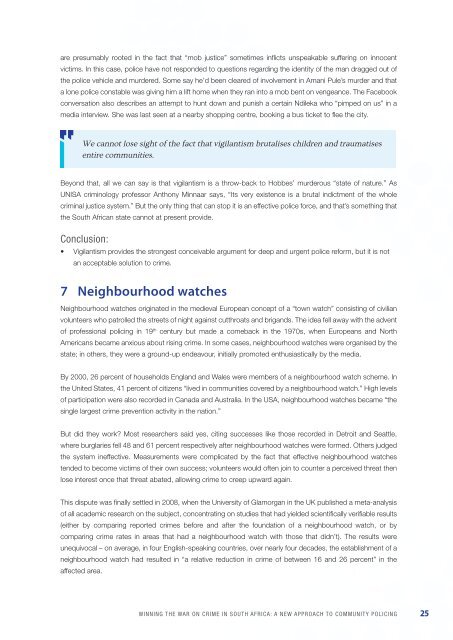2230_SAIRR_WWACinSA_sm4.indd 1 2016/09/05 5:04 PM
sairr_english_wwacinsa_print_050916
sairr_english_wwacinsa_print_050916
Create successful ePaper yourself
Turn your PDF publications into a flip-book with our unique Google optimized e-Paper software.
are presumably rooted in the fact that “mob justice” sometimes infl icts unspeakable suffering on innocent<br />
victims. In this case, police have not responded to questions regarding the identity of the man dragged out of<br />
the police vehicle and murdered. Some say he’d been cleared of involvement in Amani Pule’s murder and that<br />
a lone police constable was giving him a lift home when they ran into a mob bent on vengeance. The Facebook<br />
conversation also describes an attempt to hunt down and punish a certain Ndileka who “pimped on us” in a<br />
media interview. She was last seen at a nearby shopping centre, booking a bus ticket to fl ee the city.<br />
We cannot lose sight of the fact that vigilantism brutalises children and traumatises<br />
entire communities.<br />
Beyond that, all we can say is that vigilantism is a throw-back to Hobbes’ murderous “state of nature.” As<br />
UNISA criminology professor Anthony Minnaar says, “Its very existence is a brutal indictment of the whole<br />
criminal justice system.” But the only thing that can stop it is an effective police force, and that’s something that<br />
the South African state cannot at present provide.<br />
Conclusion:<br />
• Vigilantism provides the strongest conceivable argument for deep and urgent police reform, but it is not<br />
an acceptable solution to crime.<br />
7 Neighbourhood watches<br />
Neighbourhood watches originated in the medieval European concept of a “town watch” consisting of civilian<br />
volunteers who patrolled the streets of night against cutthroats and brigands. The idea fell away with the advent<br />
of professional policing in 19 th century but made a comeback in the 1970s, when Europeans and North<br />
Americans became anxious about rising crime. In some cases, neighbourhood watches were organised by the<br />
state; in others, they were a ground-up endeavour, initially promoted enthusiastically by the media.<br />
By 2000, 26 percent of households England and Wales were members of a neighbourhood watch scheme. In<br />
the United States, 41 percent of citizens “lived in communities covered by a neighbourhood watch.” High levels<br />
of participation were also recorded in Canada and Australia. In the USA, neighbourhood watches became “the<br />
single largest crime prevention activity in the nation.”<br />
But did they work? Most researchers said yes, citing successes like those recorded in Detroit and Seattle,<br />
where burglaries fell 48 and 61 percent respectively after neighbourhood watches were formed. Others judged<br />
the system ineffective. Measurements were complicated by the fact that effective neighbourhood watches<br />
tended to become victims of their own success; volunteers would often join to counter a perceived threat then<br />
lose interest once that threat abated, allowing crime to creep upward again.<br />
This dispute was fi nally settled in 2008, when the University of Glamorgan in the UK published a meta-analysis<br />
of all academic research on the subject, concentrating on studies that had yielded scientifi cally verifi able results<br />
(either by comparing reported crimes before and after the foundation of a neighbourhood watch, or by<br />
comparing crime rates in areas that had a neighbourhood watch with those that didn’t). The results were<br />
unequivocal – on average, in four English-speaking countries, over nearly four decades, the establishment of a<br />
neighbourhood watch had resulted in “a relative reduction in crime of between 16 and 26 percent” in the<br />
affected area.<br />
WINNING THE WAR ON CRIME IN SOUTH AFRICA: A NEW APPROACH TO COMMUNITY POLICING 25<br />
<strong>2230</strong>_<strong>SAIRR</strong>_<strong>WWACinSA</strong>_<strong>sm4.indd</strong> 25<br />
<strong>2016</strong>/<strong>09</strong>/<strong>05</strong> 5:<strong>04</strong> <strong>PM</strong>


